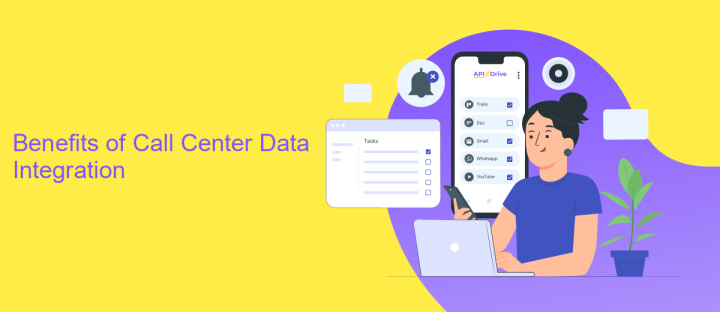Call Center Data Integration
In today's fast-paced business environment, effective call center data integration is crucial for enhancing customer service and operational efficiency. By seamlessly merging data from various sources, companies can gain a comprehensive view of customer interactions, streamline processes, and make informed decisions. This article explores the significance of call center data integration and its impact on improving overall performance and customer satisfaction.
Call Center Data Integration Overview
Call center data integration plays a crucial role in enhancing the efficiency and effectiveness of customer service operations. By consolidating data from various sources, it enables call centers to gain a comprehensive view of customer interactions, preferences, and history. This holistic approach helps in delivering personalized experiences and resolving issues more swiftly.
- Improved customer satisfaction through personalized interactions
- Streamlined operations by reducing data silos
- Enhanced decision-making with real-time analytics
- Increased agent productivity and efficiency
- Better compliance with data protection regulations
Incorporating data integration solutions allows call centers to leverage advanced analytics and machine learning tools, providing deeper insights into customer behavior and trends. This not only helps in optimizing current operations but also in forecasting future needs and challenges. Ultimately, a well-integrated data system is essential for maintaining a competitive edge in today's fast-paced customer service landscape.
Benefits of Call Center Data Integration

Integrating call center data streamlines operations by consolidating information from various sources into a unified system. This holistic view enables better decision-making, enhances customer service, and boosts efficiency. By having access to real-time data, agents can respond swiftly to customer inquiries, reducing wait times and improving overall satisfaction. Additionally, integrated data helps in identifying patterns and trends, allowing for proactive measures to address common issues and optimize workflows.
One of the key tools in achieving seamless data integration is ApiX-Drive. This service simplifies the process by automating data transfer between different systems, ensuring that all relevant information is up-to-date and accessible. ApiX-Drive’s user-friendly interface and robust functionality make it an ideal solution for call centers looking to enhance their data integration efforts. By leveraging such tools, call centers can focus more on strategic initiatives rather than manual data management, ultimately driving better business outcomes.
Challenges of Call Center Data Integration

Integrating data in a call center environment presents several challenges that can hinder efficiency and data accuracy. These obstacles must be addressed to ensure seamless operations and optimal customer service. Below are some of the primary challenges faced during call center data integration:
- Data Silos: Disparate systems and databases often lead to isolated data silos, making it difficult to achieve a unified view of customer interactions.
- Data Quality: Inconsistent and inaccurate data can compromise decision-making and customer service quality.
- System Compatibility: Integrating various software and platforms can be complex due to differences in technology stacks and data formats.
- Real-time Data Processing: Ensuring real-time data synchronization across multiple channels is challenging but crucial for providing timely customer support.
- Security and Compliance: Handling sensitive customer information requires stringent security measures and adherence to regulatory standards, which can complicate integration efforts.
Addressing these challenges requires a strategic approach, leveraging advanced integration tools and methodologies. By overcoming these obstacles, call centers can achieve a cohesive data environment that enhances customer satisfaction and operational efficiency.
Best Practices for Call Center Data Integration

Effective call center data integration is crucial for enhancing customer service and operational efficiency. To achieve seamless integration, it's essential to adopt a strategic approach that aligns with your business goals and technological capabilities.
Begin by assessing your current data infrastructure and identifying key integration points. This will help in understanding the scope of the integration and the resources required. Additionally, involving stakeholders from different departments ensures that all perspectives are considered, leading to a more comprehensive integration plan.
- Utilize APIs for real-time data exchange.
- Ensure data consistency and accuracy with validation processes.
- Implement robust security measures to protect sensitive information.
- Regularly monitor and update integration protocols to adapt to changing needs.
- Provide training to staff on new systems and workflows.
By following these best practices, call centers can achieve a higher level of data integration that supports improved decision-making and customer satisfaction. Continuous evaluation and adaptation of the integration strategy will ensure long-term success and scalability.
Case Studies of Successful Call Center Data Integration
One notable example of a successful call center data integration is the case of a large e-commerce company that utilized ApiX-Drive to streamline their customer service operations. By integrating their CRM, email marketing, and telephony systems through ApiX-Drive, they were able to create a unified platform that provided agents with real-time access to customer data. This integration not only reduced the average handling time by 20% but also improved customer satisfaction scores by 15%, as agents could resolve issues more efficiently and personalize interactions based on comprehensive data.
Another case study involves a healthcare provider that faced challenges in managing patient inquiries across multiple channels. By leveraging ApiX-Drive for data integration, they connected their call center software with electronic health records (EHR) and appointment scheduling systems. This seamless integration enabled call center agents to access patient information instantly, reducing wait times and ensuring accurate responses. As a result, the healthcare provider saw a 25% increase in patient satisfaction and a significant reduction in operational costs due to improved efficiency and data accuracy.
FAQ
What is Call Center Data Integration?
Why is Call Center Data Integration important?
What are the common challenges in Call Center Data Integration?
How can I automate Call Center Data Integration?
What are the benefits of automating Call Center Data Integration?
Time is the most valuable resource in today's business realities. By eliminating the routine from work processes, you will get more opportunities to implement the most daring plans and ideas. Choose – you can continue to waste time, money and nerves on inefficient solutions, or you can use ApiX-Drive, automating work processes and achieving results with minimal investment of money, effort and human resources.

